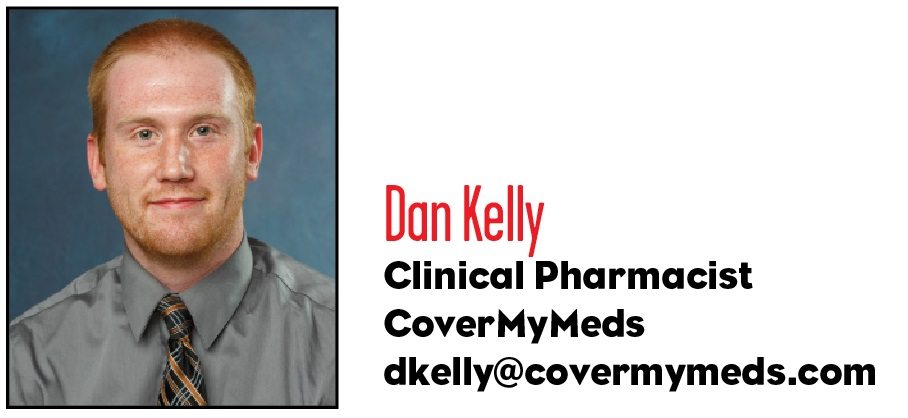Step therapy, or “fail first” as it is sometimes called, requires patients to first attempt treatment with one drug before the payer will allow coverage of the treatment initially prescribed by the physician. Payers implement these protocols as a way to manage costs by first steering a patient to a generic or formulary-preferred drug. This process can sometimes take months to complete and over that time the patient’s condition may worsen and their responsiveness to therapy may diminish.
PM360 queried several experts in this area, including one physician, on what can be done to overcome this barrier and help patients get on the treatment their physicians preferred faster. We asked them:
- What can pharma companies or physicians do to get patients on the initially prescribed medication without having to fail to get results with other options first?
- Several states have or are working on legislation regarding step therapy protocols and potential medical exceptions that would allow physicians to skip the process. How will the various state laws affect the industry? Which ones are worth keeping a close eye on?
- Is there anything the industry can do to advocate for more medical exceptions or to help physicians show why their branded product qualifies for a medical exception?
- What other strategies would you recommend to overcome step therapy protocols and help patients get access to branded pharmaceuticals not on formulary faster?
The step therapy process may take months to complete before a patient can be covered for the medication originally prescribed. So, what can clinicians do to improve the chances that their patients will receive the medication or treatment, without delay, that they believe is best?
1. Somewhat counter intuitively, use generic medications and formulary medications where appropriate for the individual patient’s condition. Taking this approach as the initial default strategy strengthens the credibility of the prescriber when he or she chooses to order a non-generic or non-formulary medication. Engage patients in “shared decision making,” as to whether a particular agent may be best for that individual.
2. Thoroughly document rational for prescribing a specific agent based on available Appropriate Use Criteria and Clinical Practice Guidelines (CPG) as supported by randomized clinical trial (RCT) data. Patients present along an infinite, analogue continuum, whereas Pharmacy Benefit Managers’ (PBM) algorithms are binary or “black and white.” Cite evidence-based decision making to support prescribing.
3. Providers, families, and community leaders must advocate on behalf of patients locally within hospitals and health systems, in state legislatures, and nationally through professional societies. The American College of Cardiology (ACC) is joining with the American Medical Association, and other medical societies, to develop a set of common-sense principles to help govern the prior authorization (PA) process.
4. Document the PA process in detail for each patient. A provider or practice may be granted “gold card status,” removing them from the obligation of routine PA, if they can demonstrate for a large enough number of patient cases where their rate of denial for PA is very low. “Gold card status” then can be included in payer contracts when renegotiated.
5. Leverage population data captured in electronic health records (EHRs) and clinical registries. Large sets of pooled clinical data will be very influential when dealing directly with PBMs, regulatory bodies, and in informing the public.
Benjamin Franklin said, “By failing to prepare, you are preparing to fail.” When it comes to managing pre-authorizations or step edits or tier 2 and beyond, there is no magic bullet. The work required to address step therapy should start in the clinical planning process. Granted, drug approval pathways and commercialization strategies are often misaligned because the goal of each practice is different, but progressive organizations begin the process for commercialization in conjunction with clinical development knowing that achieving broader product goals demands such coordination.
In healthcare marketing, communications, and informatics, many organizations take an analytical and strategic approach (key first principles to strive toward) to business and marketing analytics, KOL identification and engagement, and regulatory insight. Most pharma companies already take a similar planned strategic approach to market assessment, pricing strategy, marketing, etc. While that same approach is needed to address market barriers based on cost, pharma companies not infrequently tend to disregard their first principles when addressing reimbursement hurdles.
Key Questions to Address
The critical question is: What is cost and what is value to the payer? In today’s pharma-political climate, a generic pharmacoeconomic (PE) analysis is insufficient. Companies need to apply first principles to PE and value-based analyses in the context of the payer community. For example: What are the dynamics of the target marketplaces? What are current insurer national or local coverage determinations in the clinical space and what are determinants? With foundational insights, the requirements needed to build a value proposition within the context of the clinical landscape, payer community, and healthcare marketplace can be determined.
If the question is what to do if the hard work was not done before running into the step therapy roadblock, sorry, there still is no magic bullet and the job is harder. Franklin was a smart man.

Cost-based steps have historically demonstrated a substantial impact on utilization rates. These requirements are not implemented to confirm clinically appropriate use by prescribers—they are employed to promote the most cost-effective treatment pathway for the majority of patients. Requirements intended to ensure clinically appropriate use are unlikely to significantly hinder product utilization. It is their cost-based cousins that should have manufacturers most concerned.
Manufacturers can address these concerns before or after treatment decisions. Medical exceptions are the best tool for navigating cost-based steps after treatment decisions. However, this process can be onerous for prescribers, and manufacturers should take initiative to remove these requirements in advance of treatment decisions. Three key methods to remove barriers before treatment decisions are:
1. Conduct comparative effectiveness studies, which are among the most desired manufacturer-sponsored resources by payers. Establishing clinical superiority relative to the standard-of-care is lightyears ahead of placebo trials when it comes to demonstrating value in a controlled study.
2. Leverage real-world evidence, which incorporates economic considerations into the value equation. Manufacturers must demonstrate clinical superiority and translate that into a clear economic benefit through cost offsets. This would help alleviate concerns around providing first-line access to a higher cost agent.
3. Shared-risk contracting, which accounts for outcomes when providing rebates. If the drug fails to deliver on the value promise, then the manufacturer pays a larger rebate. This is the optimal method to minimize cost-based steps. It builds on a strong clinical data, leverages internal payer data, and provides discounts based on outcomes.
These are methods that manufacturers should leverage in combination to limit the implementation of cost-based steps, and they all share one key trait—they all require compelling data to demonstrate value.
Step therapy is a strategy that works well in therapeutic areas such as dyslipidemia, in which effective drugs such as atorvastatin (Lipitor) are available first-line. In areas such as cancer or chronic diseases, however, steps can create barriers to costly but effective biologic medicines.
In psoriasis, for example, methotrexate is often used first-line. Though relatively inexpensive, methotrexate has limited effectiveness and can cause hepatotoxicity, fatigue, and stomatitis. A recent Institute for Clinical and Economic Review (ICER) report recommends the abolition of step therapy in psoriasis, or using steps only for patients with moderate-to-severe plaque psoriasis (http://bit.ly/2iFWdsi). The National Psoriasis Foundation has pursued legislative action against step therapy.
Pharma can help payers look beyond short-term, cost-control strategies to identify the longer-term efficiencies of successful early treatment in specific therapeutic areas by:
1. Demonstrating the value of investing in more effective treatment sooner:
- Suboptimal treatment and poor adherence cause costs to proliferate.
- Cycling through drugs within the same class is generally ineffective and sustains costs.
- Example: When a TNF inhibitor is ineffective in a patient with an inflammatory disease, select a product with a different mechanism of action (e.g., Entyvio or Orencia).
2. Supporting HCPs and patients when early step treatments are ineffective and could result in additional healthcare costs:
- Educate and assist HCPs to identify and document treatment failures, including paperwork and claims processes.
- Promote HCP awareness of medical exception policy in individual states as a “red button” to move to a more effective treatment sooner.
- Thirteen states currently have laws overriding step therapy when adverse events or treatment failures are reported; more are expected to follow.
3. Providing payers with tools to identify patient types incurring greater costs due to step therapy:
- Example: Cigna and AstraZeneca’s partnership to identify patients who would benefit from skipping steps to receive Crestor

As health insurers increasingly turn to step therapy as a method of controlling healthcare costs, providers and patients will need to engage with payers to ensure that they receive the medications that will be most effective in treating their conditions. Field reimbursement managers and payer account executives supported by manufacturers are key to helping providers and patients deal with, and potentially overturn, step therapy. This typically occurs in a phased approach, in which some patients go through the step therapy process and their feedback is aggregated to tell a compelling story that resonates with the payer.
The ability to demonstrate a higher level of efficiency without step therapy (for example, 85% of all step therapies are overturned) gives payers the data necessary to change their policies. Ultimately, the goal for manufacturers, providers, payers, and patients is to ensure that patients are able to access the most clinically appropriate therapies without a lot of administrative headaches and in a reasonable amount of time.
Use Data to Overcome Step Therapy
To help patients get access to medication, it’s important to understand why payers often use step therapy. When evaluating a treatment, payers’ top concerns are safety, efficacy, and price. Manufacturers, physicians, and patients can overcome step therapy protocols and access certain medications faster by using outcomes data to address payers’ concerns. Data that demonstrates increased adherence, decreased hospitalization, less depression, reduced absenteeism, or other benefits to one medication over another can help to decrease the likelihood of step therapy or move the product up on the step list.

Despite the access challenges step therapy edits impose, they are critical tools for health plans to manage drug cost and trend. The first step towards circumventing their prerequisites is to acknowledge that step therapy programs are designed to promote cost-effective drug utilization. Navigating within this environment requires drug manufacturers and physicians to identify strategies that provide appropriate access for patients, yet are careful not to undermine the payer’s need to manage cost.
Directionally, drug manufacturers can consider two avenues regarding step therapy imposition: 1) prevention and 2) cooperation. Prevention of step therapy imposition starts with net cost discussions; however, other strategic entry points that may resonate with health plans could include:
- Brand on generic tier
- Member disruption impacts
- Medicare coverage gap implications (plan and member)
- Partnership programs with long-term benefits (e.g., outcomes, portfolio, pipeline)
When prevention fails, cooperation with health plans is usually the best means for access. These strategies are geared towards appropriate use monitoring. Examples include:
- FDA label consistency
- Evidenced-based guideline education
- Prescribing community education
Arguably, physicians play the greatest role in navigating step therapy edits as they contribute to prevention and cooperation strategies, but also drive access through the payer exception process. Through KOL avenues, prevention strategies focus on guideline creation and P&T committee influence. Cooperative approaches center upon guideline adherence and appropriate drug use. But the physician’s ability to maneuver the payer exception process offers the greatest opportunity for drug manufacturers to help facilitate this process. Physician/drug manufacturer strategies may include:
- Establishment of prior use (e.g., patient assistance and discount co-pay programs)
- Medical necessity attestation (especially Medicare Part D)
- Appropriate and prompt trial progression (i.e., 30-, 60-, 90-day supplies as defined by plan)
- Concierge programs to aid with exception process specifics
As increased prescription drug spending continues to be a hot topic, it can be anticipated that step therapy edits will continue to be used by payers to control cost. Prescribers can adapt their practices to best navigate these edits with the following steps:
1. Prescribers should continue to consider appropriate multi-source, generic medications as first-line options for therapy to decrease the number of step therapy requests they need to complete.
2. During the prescription selection process, prescribers should leave detailed and succinct rationale for the selection of the medication in their patient chart history, including reasons for not using lower-cost generic medications and notes on all previously tried therapies. This will allow their staff members to provide the information necessary for the insurance plan to approve the step therapy override and reduce administrative error. Administrative error that results in denials of coverage is a common problem that becomes more frequent with specialty medications that have more complex approval criteria (such as multiple step levels, treatment duration requirements, and lab results submissions).
3. Prescribers should familiarize themselves with any relevant state legislation that regulates step therapy protocols where they practice.At least 11 states now have regulations on step therapy policies for insurance sold and regulated within their jurisdiction, many of which require plans to cover step therapy medications if the patient is already on the drug and has evidence of clinical improvement. Educating staff members on these policies can further reduce administrative error that could result in a denied coverage request. Many other states have similar legislation currently introduced, and prescribers can help serve as advocates to promote passage of these laws in a manner that acknowledges the benefits of step therapy but emphasizes doing what is best for each patient and reducing administrative burden on HCPs.

Under the right circumstances, step therapy can be consistent with good clinical practice and responsible cost control. When based on strong evidence of comparative effectiveness, safety, and cost effectiveness, step therapy can contribute to high-quality patient care when managing total healthcare costs is a priority (as it usually is). A number of situations exist, however, in which rigid step therapy protocols don’t best serve patients’ interests.
Weak Evidence
Some step therapy restrictions are based on weak comparative clinical evidence or are based solely on drug cost savings (as opposed to true cost effectiveness that considers all healthcare costs and any trade-off between cost and clinical benefit). As an example, a generic drug that has lower acquisition costs, but results in more hospitalization costs due to side effects than a branded alternative, would be a poor choice for first-line step therapy.
Mandating Off-label Use
Another disputable step therapy approach is mandatory off-label use of a generic medication, in which a generic is used in preference over a branded treatment that is labeled (and therefore has a clear evidence advantage) for that indication.
Disregarding Patient Variability
Importantly, step therapy protocols need to recognize that the benefits of any given treatment option may vary across patients. When assessing the most appropriate treatment, the role of patient input (combined with physician judgement) needs to be respected, and exceptions to specific step therapy restrictions must be facilitated, particularly if the patient’s prognosis is considered to be at risk.
Inappropriate Alignment of Patient Co-pays
Lastly, patient co-pays should be aligned to optimize patient access and adherence when step therapy is being followed and initial options fail. For example, a patient that is prescribed a more expensive medication when initial step therapy options fail should not suffer from unreasonably higher co-pays that could result in poor adherence and poor health outcomes.

Step therapy is not a new problem and I’d argue, at times, it’s actually good for pharma, particularly for companies with a significant volume of specialty products and those preparing to launch a novel drug in a crowded therapeutic category. Step edits require a patient to fail first on a different treatment, a process allowing payers to use clinical criteria as a way to control utilization of high-cost and less effective drugs, and perhaps those with more side effects or toxicity. When a patient does meet the criteria and when they have a positive outcome (i.e., improvement in quality life, fewer hospitalizations), the drug begins to build a real-world clinical profile. For example, if a patient fails on a tier-2 preferred therapy to treat multiple sclerosis or rheumatoid arthritis, then has success on a company’s fourth-line drug, that company can start to build an outcomes story and perhaps increase access.
Adjust Your Launch Plans
In the past 10 years, many companies have tried to circumvent payer formulary strategies sometimes by taking almost too broad of an approach in their launch plans, like by targeting a wide-swath of physicians or failing to help the payer evaluate impact on survival and quality of life months. Is the additional $90,000 per cancer treatment worth it for another one month of life quality—these are tough questions that payers don’t have complete answers to, but could be an avenue for companies to provide value. In one situation, a brand team charged with launching a novel chronic obstructive pulmonary disease treatment wanted to market it to primary care physicians and many others, rather than focus only on pitching the product to pulmonologists. Medical directors urged the company to target its post-launch promotion, but they wouldn’t and ultimately faced more restrictions—including prior authorization.












